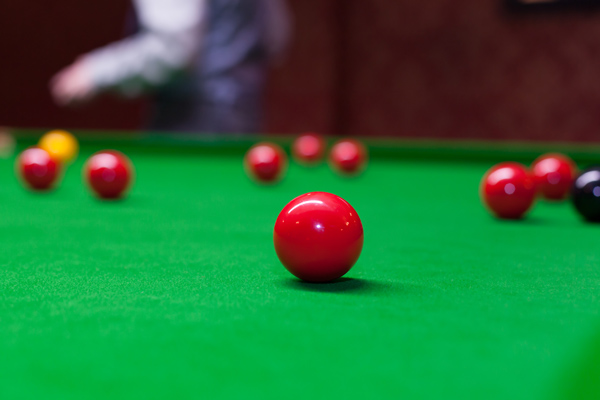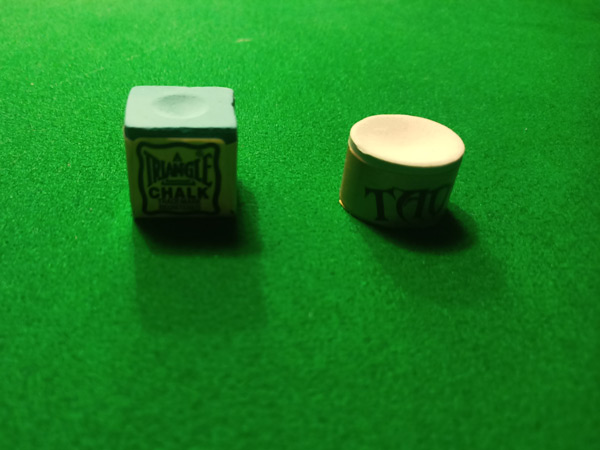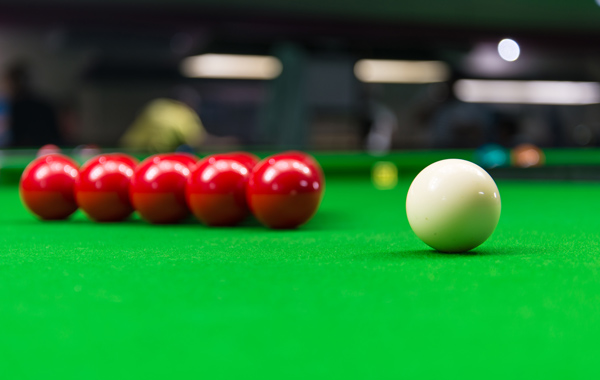In this article we’ll go over exactly what a kick is in snooker and what causes it. We’ll also explore ways to prevent kicks or at least reduce the chances of them happening. Keep reading to find out everything you could possibly want to know about kicks in snooker!
In snooker, a kick is where there is a “bad contact” between 2 balls, usually between the cue ball (white ball) and the object ball (ie a red). This is typically thought to be as a result of chalk being present between the balls on contact.
As a result of this “bad contact”, the balls do not react as they would normally. This can cause the player to miss a shot that would otherwise have gone in the pocket or to run out of position with the cue ball (white ball).

A kick in snooker is not to be confused with a kick shot in pool, which is a shot where the cue ball is played into a cushion (rail) before hitting the object ball. In American pool, a “cling” is the same as a “kick” in snooker.
Kicks produce unpredictability and they are many snooker players worst nightmare! If you’ve played any snooker or pool yourself, chances are you’ve experienced a kick, whether you realised it or not!
When a kick happens, they are normally a couple of effects on the balls. These are as follows:
Firstly, the “bad contact” usually means that some pace is taken out of the balls. The common effect is that both the white ball and the object ball don’t travel as far as they otherwise would’ve done.
This is not normally a problem for the object ball (for example a red) as this usually has plenty of pace to reach the pocket. So even though it has lost some pace, it typically still has enough speed to go in the pocket.
However, the loss of pace on the cue ball can cause a lot of problems for the player. The white can finish short of the intended position, leaving the player with a difficult shot.
Secondly, the kick usually changes the angle of the balls, especially the angle of the object ball. The kick often narrows the angle the object ball travels on, or in other words it effectively makes the contact “thicker”.
For example, lets say we are cutting the blue ball to the left middle. A kick would likely make the object ball (the blue) travel on a thicker path, towards the right side of the pocket. This may mean that we miss the pot, even though it would’ve gone in if it weren’t for the kick.
The main reason for the kick is thought to be the presence of chalk between the 2 balls. This effecticely increases the friction between the balls, causing them to travel slower and on a norrower (or thicker) path. The balls also tend to “jump” slightly when a kick occurs.
Chalk is very important in snooker, increasing friction between the cue and the cue ball (white ball). This mostly prevents miscues and allows players to use spin on their shots.

But the chalk can cause a problem from time to time when it gets onto the balls. Since the cue ball is continually making contact with the chalk on the cue, it can “pick up” (collect) some of this chalk. When chalk on the cue ball comes in contact with another ball (the object ball), it can cause a kick.
But the cloth manufacturer Strachen studied kicks closely, and according to them, the main way that balls pick up chalk is as they move along the cloth. Their findings indicated that as the snooker balls (made from phenolic resin) travel accross the cloth, they produce static electricity. This in turn causes chalk and dust particles from the cloth to accumulate on the balls.
There are a few different ways that you can tell when a kick has happened in snooker. The main ways are as follows:
I say “usually” because no 2 kicks are the same. A kick doesn’t necessarily produce all 3 of the effects above. Or at least all 3 aren’t always noticeable on every kick.
Now let’s go into the effects of a kick in more detail.
The first sign of a kick is usually the sound it makes. A kick typically produces a duller sound. This is due to the chalk between the balls and this can usually be heard as soon as the player has played the shot (when the balls make contact).
Whereas snooker balls usually make quite a high pitch “clicky” sound, with a kick they often make a much lower pitch “thud” sound. That might not be the best description but it’s the best way I can describe it!
At least now that you know the difference you can listen out for it. If you pay attention to the sound of the contact on each shot you should quickly learn to spot a kick and it will become second nature.
The other way in which you can identify a kick is that it usually causes the balls to jump (leave the bed of the table). This is often quite subtle though so it can be difficult to spot. But this is thought to be caused by the increased friction as a result of the presence of chalk in the impact.
A kick can cause the balls to “jump” even on a very slow shot. If a slow shot is played and the balls jump, this is a pretty much sure fire sign of a kick.
Also, I think it’s worth mentioning that the balls can jump on contact during normal play (ie not due to chalk). This can happen if the white ball is bouncing slightly as it makes contact with the other ball, throwing the balls upwards and off the surface table.
This effect is particularly common when playing with lots of power and/or spin, especially if a player is having to cue down steeply on the white.

Some people still class this as a kick, even though it’s not usually caused by chalk. Personally, I don’t tend to class this as a kick since it’s largely a result of the particular shot played, as opposed to something outside the player’s control (ie chalk). But whether you class this as a kick or not is entirely up to you!
The final way that a kick can be identified is by the way it affects that balls, making them travel slower and on a different path (narrower angle).
Being able to spot this just comes from experience. Usually, you can tell a kick from the sound or the jump, and then you can confirm the kick from the position of the balls.

It’s important to understand when a kick has happened since it’s beneficial to know whether the shot was caused by your actions or by something which you couldn’t control (a kick). Being able to identify the difference can help your development as a player, as well as increasing your enjoyment from playing or spectating snooker.
Having said that, I can’t guarantee you won’t get frustrated when a kick happens to you! It can be infuriating when a kick spoils an otherwise good shot!
A kick can happen on virtually any shot in snooker but it seems to be much more common on slow shots. The exact reason for this is not known but I’ll explain my thoughts below.
My theory is that kicks are just as common on fast shots as slow shots. But perhaps the effects on slow shots are greater than fast shots.
On a fast shot, the force of the balls could negate a lot of the effects of the kick. Whereas on a slow shot, the lack of force means that the kick can have a larger impact on the balls, relatively speaking.
I hope that makes sense. It’s only a theory but it certainly seems that kicks happen more, or have a greater effect, on slows shots. Some professionals have even explained how they like to play certain shots with more power to reduce the probability of a kick.
If you’re a spectator of the professional game, you’ve proabably noticed a lot less kicks. In fact, I’m a big snooker fan and I can’t even remember the last time I saw a kick in the professional game! But how have they reduced the number of kicks?!
Professional snooker plays are often claim that the new Toam chalk is the reason behind the huge reduction in the number of kicks in snooker.
When asked about the reduction in kicks, top snooker player Shaun Murphy was quick to respond with the following:
“It’s the chalk, I’m doing lots of corporate events where there are all sorts of different cloths and the chalk is working on all of them.” – Source

This would seem to imply that the chalk is the only factor that’s helped to reduce kicks. Whilst it certainly seems to be a large factor, players who haven’t adopted the new chalk have also experienced reductions in kicks on their shots.
There would appear to be more to this than meets the eye, at least in the professional game. And the answer could come from the cloth manufacturer Strachen.
Once Strachen had closely studied kicks, and determined that static electricity between the balls and cloth was the problem, they set about designing a new cloth.
The result was the Strachen anti-static cloth. They had found that by adding a tiny amount of carbon fibre to their No.10 cloth, they could drastically reduce the static build up.
According to Strachen, since introducing their new cloth, they saw an 80% reduction in the number of kicks.

So the new anti-static cloth, combined with the new Toam chalk would seem to explain why there are less kicks in snooker these days.
From a spectator’s point of view, I think the game has been improved with less kicks. Fewer kicks mean higher breaks and less bad luck. But I suppose you could argue there was more drama in the game when a kick was waiting just around the corner!
The new chalk is called Taom chalk. It is produced by a Finnish company and it’s marketed as a solution to almost completely eliminate kicks.

The idea behind the innovation was to create a chalk that didn’t produce chalk dust on contact like regular snooker chalk. This would prevent the cloth from becoming saturated with chalk, reducing the chances of kicks. Of course, it was still important that the chalk worked like a regular chalk, gripping the cue ball, therefore preventing miscues and allowing players to use sidespin.
It seems like they succeeded as many professional snooker players are claiming that switching to Taom has vastly reduced the number of kicks they get.
It certainly seems that more and more players are adopting the new chalk. It may just be a matter of time before every player is using Taom chalk or one formulated in the same way.
If it reduces kicks then I’m all for the new chalk! Innovation in snooker is probably a bit overdue anyway, in my opinion.
A kick in snooker can be devestating to a player’s break, causing them to miss a shot or lose position. But it’s important for players to accept that this is a part of the game and to not get frustrated. As with most sports, frustration can lead to poor performance.
And remember there are ways to reduce the occurance of kicks. Aside from fitting an anti-static cloth which isn’t an option for most people, you can try the new Taom chalk.
Also, the cleaness of the cloth can make a huge difference. If it has a large amount of chalk on its surface then it’s quite likely that the balls will pick up chalk, increasing kicks. Brushing the cloth well before the start of a session is probably a good idea. This should help to remove a lot of the chalk from the cloth.
Additionally, it’s probably worth clean the cue ball from time to time. You wouldn’t do this after every shot but it’s quite easy to give it a quick wipe when taking it out of the pocket and before the start of each frame.

It’s also probably a good idea to give all the balls a quick wipe before each frame if possible. Of course, this could be mostly pointless if the cloth itself has a large amount of chalk on it, though it may still help somewhat.
And remember, it is just a game at the end of the day, kicks aren’t the end of the world! Even if it feels like it when you get one in the middle of a break!
Well, that’s it for this article on kicks folks. It’s all I’ve got for now! Over and out.

My name is Tom Rothwell and I’m a bit obsessed with cuesports! I’ve been playing pool and snooker since I was about 8 years old. I find American pool and English pool to be the most enjoyable with friends but I also enjoy the challenge of playing snooker.
As well as playing many different cuesports, I also enjoy watching the professionals. With this blog, I’m sharing as much of my knowledge as I can. Hopefully I can help some people out and maybe introduce some new players into the incredible games that are cuesports.